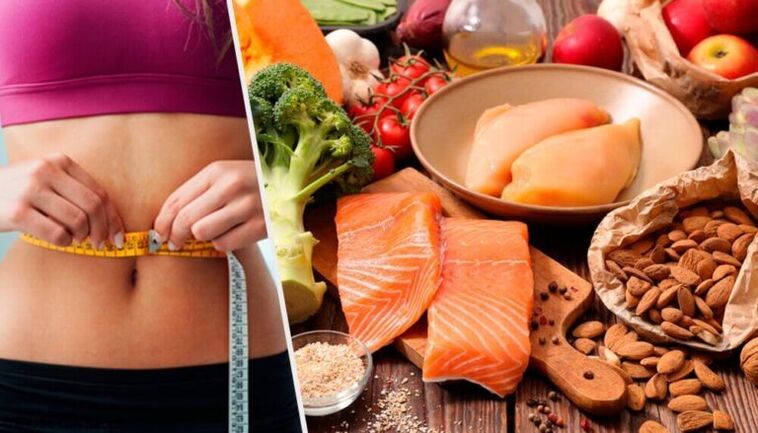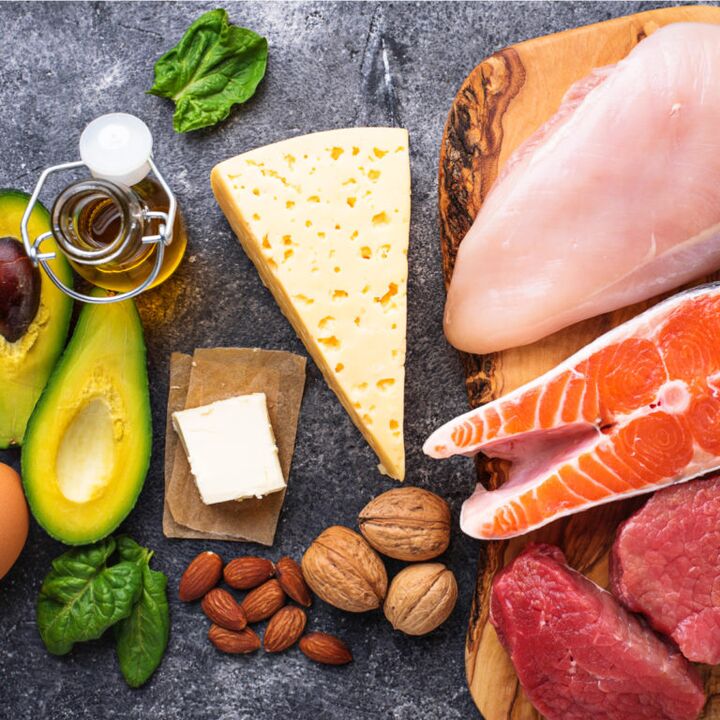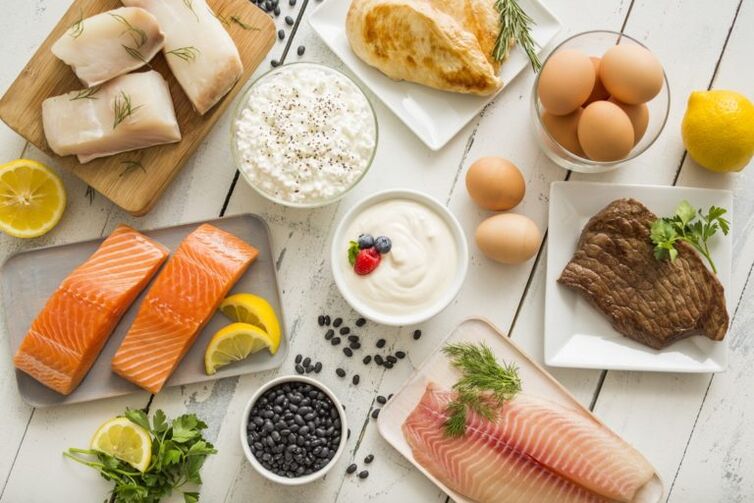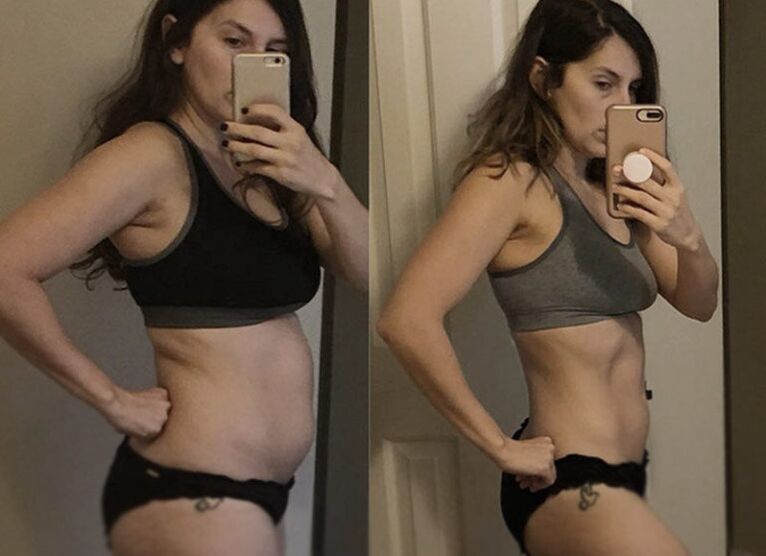
A number of studies have shown that the ketogenic diet can help improve health in diseases such as epilepsy, cancer, Alzheimer's disease, and multiple sclerosis. This diet also helps to effectively reduce weight.
In this article, you will find out the menu, the list of products, and a detailed guide for those starting their journey to the ketogenic diet. Read everything you need to know here.
What is the ketogenic diet?
Ketogenic diet, or it is also called the keto diet, bears similarities to the famous Atkins diet - a diet high in fat, low in carbohydrates and moderate in protein in the diet.
When carbohydrates are replaced by fats in the diet, the body is forced to use fat as an energy source.
How does the ketogenic diet work?
To maintain the tone of the body, nutrition and brain function, energy is needed from food. The main and fast source of energy is carbohydrates, which are processed into glucose and saturate the body with energy. If there is not enough carbohydrate food in the diet to nourish the brain, then the liver is forced to convert fatty deposits into ketone bodies and fatty acids. This diet is remarkably efficient in burning fat for energy. The body undergoes a metabolic change called ketosis, in which ketone bodies are transported to the brain and used as an energy source instead of glucose.
The ketogenic diet also has a positive effect on people with diabetes, as a low-carb diet leads to lower blood sugar and insulin levels.
Output:The ketogenic diet is a diet high in fat and low in carbohydrates. Forces the body to extract energy not from carbohydrates, but from ketones, using fat, while the level of sugar and insulin in the blood decreases.
Previously, the ketogenic diet was prescribed for children with epilepsy because the increase in ketone bodies in the blood (ketosis) reduces the incidence of epileptic seizures.
The ketogenic diet in the treatment of certain diseases
The mechanism and therapeutic effect of the keto diet has been studied and applied for a wide range of diseases:
- Alzheimer's disease;
- Autism;
- Multiple sclerosis;
- Parkinson's disease;
- Amyotrophic lateral sclerosis;
- Some forms of cancer;
- Metabolic syndrome and type 2 diabetes mellitus.
Ketogenic dietIt is also widely used by athletes involved in sports that require great body endurance. Most often, this is triathlon, cycling, marathons, when the body effectively burns fats as a source of energy in order to preserve glycogen stores in the liver during prolonged exertion.

The ketogenic diet for weight loss
The ketogenic or fat diet is widely known in Poland, and this is not surprising, since the authorship belongs to Jan Kwasniewski, a nutritionist from Poland. The diet is not only successfully used for various diseases, but also with the help of a ketogenic diet, you can quickly lose weight from 2. 5 - 3 kg per week.
Weight loss is due to the lack of carbohydrate foods in the required diet: restriction of all simple carbohydrates, flour, sweet and even potatoes. But during the keto diet, fatty foods are allowed: cheeses, lard, dairy products, vegetable oils, nuts, seeds, meat, fatty fish, from vegetables, you should give preference to fresh or frozen, low-carb and green leafy vegetables.
Types of ketogenic diet
Consider the 4 most common ketogenic diet options:
- Standard diet (SKD):a classic low-carbohydrate diet, with a predominance of high-fat and moderately protein foods in the diet. The ratios are, fat about 75%, protein 20%, and carbohydrates only 5%.
- Cyclic ketogenic diet (CKD):during the period of this diet, it is possible to include high-carbohydrate days, but no more than two within seven days. You eat a standard keto diet five days a week and a high-carb diet for two days.
- Directed diet (CDD):such a ketogenic diet permits the addition of carbohydrates to the diet only during the training period, before or after it.
- High Protein Ketogenic Diet:resembles the standard ketogenic diet, but the percentage of protein increases. It implies up to 60% fat, 35% protein and 5% carbohydrates.
However, athletes, athletes and bodybuilders are more likely to use cyclical and directed diet options, although the standard and high-protein ketogenic diets are now more studied.
In this article, we are looking at the classic version of the standard ketogenic diet, although other versions have general principles.
Output:Today, there are several options for the ketogenic diet, the most popular, recommended and well-studied of them is the standard keto diet.
How does the ketogenic diet help you lose weight?
The keto diet effectively helps to reduce excess weight and is used as a prophylaxis for certain diseases. The advantage of the diet is that weight loss occurs without boring calorie counting, but only by eliminating carbohydrates, and has advantages over low-fat diets.
This is evidenced by a study that involved people divided into 2 groups, the first group adhered to a ketogenic diet, the second sat on a low-calorie, low-fat diet, as a result, the participants in group 1 lost 2. 2 more weight than group 2.
Output:The ketogenic diet has several advantages over low-fat diets, allowing you to lose much more weight without feeling hungry. An important role is also played by a decrease in blood sugar and insulin levels and an increase in the number of ketones.

The ketogenic diet for diabetics
Diabetes mellitus is an endocrine disease characterized by insufficient insulin production, metabolic disorders associated with glucose uptake.
Eating a ketogenic diet can help burn fat and lower sugar levels, which is relevant for people with type 2 diabetes, prediabetes and metabolic syndrome.
A study found that a ketogenic diet improved insulin sensitivity by 75%. As a result of a study in which 21 patients with type 2 diabetes took part, it was found that 7 subjects significantly improved their general well-being and they could stop taking diabetes medications. This weight loss is a big plus for people with type 2 diabetes.
Another study showed that the ketogenic diet was highly effective in which participants lost 10 kg, which is different from the comparison group, whose participants ate a high-carb diet and lost only 7 kg. In addition, 90% of the ketogenic group were able to withdraw from drug treatment, compared with 60% of the high-carb group.
Output:a ketogenic diet can safely reduce weight and significantly improve well-being in patients with type 2 diabetes.
Diseases for which the ketogenic diet is considered beneficial
This type of diet was previously used to treat children with epilepsy.
The therapeutic effect of the ketogenic diet is beneficial for various neurological diseases:
- Cancer.Diet is part of metabolic therapy for some types of cancer, most promising is its use for glioblastoma.
- Alzheimer's disease.Research in 2018 showed a positive effect of using a ketogenic diet, as ketone bodies correct energy deficits, which leads to a slowdown in the progression of the disease.
- Epilepsy.Ketone bodies in the blood reduce the incidence of epileptic seizures in children, as a result of the study, in 90% of difficult cases of epilepsy, an improvement in the condition from diet for 6-12 months was found.
- Parkinson's disease.The ketogenic diet has been found to have neuroprotective and anti-inflammatory properties, and therefore has a potential therapeutic effect in this disease.
- Multiple sclerosis.The ketogenic diet has been found to have neuroprotective and anti-inflammatory properties that improve the course of this disease as well.
- Type II diabetes mellitus and metabolic syndrome.It improves insulin resistance, lipid profile, and decreases the risk of heart disease.
- Diabetes mellitus type 1.Improves glucose control, reduces the risk of hypoglycemia.
- Autism.The diet can be effective for hypometabolism in the brain, and due to its neuroprotective properties, the ketogenic diet has good therapeutic potential for this disease.
It should be borne in mind that to date, the quantity and quality of some studies has not been enough to recommend it to all patients without exception.
Prohibited foods during the keto diet
Prohibited foods containing a large amount of carbohydrates. This list of foods that need to be eliminated completely or minimized as much as possible with a ketogenic diet:
- Foods high in sugar:soda, juices, smoothies, cakes, ice cream, pastries, rolls, sweets, chips, marmalade, marshmallows and more.
- Cereals or starches:wheat products, bread, rice, pasta, cereals, baked goods and more.
- Fruits:all fruits except small portions of berries like strawberries.
- Legumes: peas, beans, lentils, chickpeas.
- Root vegetables and tubers: potatoes, sweet potatoes, carrots, parsnips, etc.
- Low-fat and dietetic foods:they have gone through many stages of processing and most often contain a lot of carbohydrates.
- Condiments and sauces:some contain sugar and unhealthy fat, mayonnaise, ketchup and others.
- Harmful fats:Cut back on processed vegetable oils, processed trans fats, hydrogenated fats, including margarine.
- Alcohol:Due to their high carbohydrate content, many alcoholic beverages can bring you out of ketosis.
- Sugar-free diet foods:they are often filled with other chemical fillers that affect ketone levels. Such food is also usually heavily processed.
Output:Avoid refined and high-carbohydrate foods made from white flour, sugar, legumes, rice, potatoes, candy, most fruits and berries.
Foods you can eat with a ketogenic diet
If you decide to try the ketogenic diet, you should know what you can eat, your meals while following this diet should consist of these foods:
- A fish: catfish, cod, flounder, halibut, mackerel, mahi-mahi, salmon, perch, trout, tuna and mackerel. Wild salmon, tuna, trout, and shellfish are especially beneficial as they can help provide a balanced Omega-3 diet.
- Seafood:shellfish, oysters, lobster, crabs, scallops, mussels and squid.
- Whole eggs:if possible, it is necessary to eat eggs from free-range hens. You can cook them in different ways, both fried and boiled.
- Beef:beef, steak, roasts and stews, make sure the tenderloin is more dense.
- Pork:pork loin, pork chops, tenderloin and ham, watch out for sugar and try to stick to leaner meats.
- Bird:chicken, goose, turkey, duck, quail, pheasant and other game.
- Offal: heart, liver, kidneys and tongue, stomachs, some of the best sources of vitamins and nutrients.
- Other types of meat: veal, goat, lamb, rabbit and other wild meats, stick to denser meats.
- Bacon and sausages:read the composition carefully to exclude the presence of sugar and other additives.
- Cheese:unprocessed cheeses (cheddar, goat, cream, blue, and mozzarella).
- Nuts and Seeds:almonds, walnuts, hazelnuts, pine nuts, flax and pumpkin seeds, chia seeds.
- Useful oils:first of all, natural olive and coconut oil, avocado oil.
- Avocado:whole avocado or freshly cooked guacamole.
- Low-carb vegetables:all non-starchy and green vegetables, also tomatoes, onions, peppers.
- Seasonings:salt, pepper and various herbs.
- Butter and cream:eat natural herbal foods.
Output:The bulk of the diet is meat, fish, eggs, oils, nuts, avocados, coconut, and plenty of vegetables with minimal carbohydrates. Whole food with one ingredient is ideal.
What to eat on a ketogenic diet?
If you are hungry, you should give preference to these beneficial ketogenic snacks:
- A fatty piece of fish or a piece of boiled meat.
- A handful of seeds or nuts.
- Buttered cheese or just cheese.
- Hard-boiled chicken or quail eggs 1-2 pieces.
- Bitter chocolate with 80-90% cocoa content.
- Low carb milkshake with almond milk, cocoa and nut butter.
- Fatty yoghurt mix with nut butter and cocoa.
- Strawberries and cream.
- Celery with salsa and guacamole.
Output:A great snack on a ketogenic diet is a piece of fish, meat, cheese, butter, boiled eggs, nuts, and dark chocolate.
How to eat out if you are on a ketogenic diet?
In any cafe or restaurant, you can easily find a variety of dishes on the menu that correspond to a ketogenic diet. Almost every cafe and restaurant has meat, fish snacks and dishes, so feel free to order them along with low-carb vegetables. Kebabs, kebabs, meat, grilled fish are great if you are on a ketogenic diet.
Egg dishes are also fine - order yourself an omelet or eggs with bacon and avocado. Another option is a cheese, vegetable plate, just make sure the vegetables are low in carbohydrates.
In Mexican restaurants, enjoy all kinds of meats and cheese, guacamole, salsa or sour cream. For dessert, ask for a cheese mixture or double cream with berries.
Output:When eating out, order meats, fish, cheeses, avocados, eggs, bacon, and low-starch vegetables.
Potential Side Effects of the Ketogenic Diet and How to Minimize Them?
When any changes occur, this concerns the climate, nutrition, regime and other things, a person has his own individual sensitivity and periods of adaptation, the ketogenic diet is no exception and can have an undesirable effect on the body, which is manifested by the so-called"Keto flu", which passes in a few days.
Symptoms "keto flu "include feelings of strong hunger, distraction, lack of strength and energy, sleep disturbances, nausea, headache, discomfort in the abdomen, decreased mental and physical performance.
To minimize side effects, consume enough clean water, get enough sleep, avoid overuse, add potassium-rich foods (green leafy vegetables, avocados) to your diet, and moderate amounts of salt to taste will help maintain a healthy electrolyte balance in the body. Reduce the negative manifestation "keto flu "eating enough healthy fats will help, and gradually, slowly reducing carbohydrates in the diet can make it easy to switch to a keto diet and reduce symptoms. "keto flu ". . .
Important:The ketogenic diet can also alter the body's water and mineral balance, so extra salt in food or mineral supplements may be needed.
When it comes to supplementation, supplementation with mineral supplements, especially sodium, potassium and magnesium, should be taken while on a ketogenic diet to reduce side effects. The method of administration and dosage will be helped by a specialist.
When switching to a ketogenic diet, especially at the very beginning, you need to eat your fill and avoid calorie restriction, since keto food allows you to get rid of extra pounds without counting and restricting calories.
Output:"Keto flu" and other side effects of the diet will be minimal if you follow certain rules, especially you should pay attention to an adequate drinking regime, the presence of salt and mineral supplements to food.
Supplements for the ketogenic diet
Additional supplements during the diet are not necessary, however, some of them may be beneficial.
- Minerals:salt and minerals are essential at the beginning of the journey to normalize electrolyte balance.
- Caffeine:The caffeine in coffee can help fill the energy deficit associated with adjusting to a new diet, as well as associated with weight loss.
- Exogenous ketones: in consultation with the doctor, in order to increase the level of ketones more.
- Creatine:a substance of natural origin, will help to increase the body's endurance, and in combination with physical training will help to lose weight even more effectively.
- Serum:A healthy source of protein, use half your whey protein in shakes or yoghurts to increase your total protein intake.
Output:Some supplements are beneficial for the ketogenic diet, look out for exogenous ketones, whey, and minerals.

Answers to frequently asked questions for those who have opted for a ketogenic diet
Here are the answers to some of the most frequently asked questions about the ketogenic diet.
Can you ever start eating carbs again?
Yes, the main condition is to exclude them at the initial stage of the ketogenic diet. 2-3 months after starting the diet, you will be able to consume carbohydrates on special occasions or on holidays, and then immediately return to the diet again.
Will muscle mass go away?
The risks of loss of muscle mass are possible with any diet, a large amount of protein and a high level of ketone bodies will help level them, especially if you are involved in sports that require high endurance of the body or lifting weights.
Can you build muscle on a ketogenic diet?
It is possible, but it will turn out slower than with diets where the carbohydrate content in the diet is moderate.
Do I need to "stock up" on carbohydrates before a ketogenic diet?
Not necessary. However, a few high-calorie days are best done before starting the diet.
How Much Protein Should You Eat Per Day?
Excessive amounts of protein can lead to higher insulin levels and a decrease in the number of ketone bodies. A moderate protein intake is recommended, which is approximately 35% of the total calorie intake.
What if you constantly feel tired?
This means that you have not yet reached a state of increasing blood ketone levels. It is necessary to reduce the amount of carbohydrates, monitor the drinking regime, add salt and additional minerals to the diet.
Why does urine smell like fruit?
It's okay, this is a feature of ketone byproducts.
I feel bad breath, what should I do?
A common side effect of the ketogenic diet is to increase the amount of water consumed, and regular chewing gum will also help.
Is the state of ketosis dangerous for health?
The main thing is not to confuse ketosis with ketoacidosis. The state of ketosis is quite natural, this is a variant of the norm, it is not dangerous to health, and ketoacidosis appears with an uncontrolled diet and it is he who is really considered dangerous.
What to do with digestive problems and diarrhea?
Another side effect of the ketogenic diet that should go away in a month. If the problems persist, include vegetables rich in fiber and magnesium.
Is the ketogenic diet contraindicated and not suitable for everyone?
- The ketogenic diet is effective and suitable for overweight people with diabetes, metabolic syndrome and anyone who wants to improve their metabolism.
- It is less suitable for athletes looking to gain muscle mass or body weight.
- The ketogenic diet will only work to burn fat if you stick to it for an extended period of time.
- The ketogenic diet is great, it is a way of eating that you can safely and quickly lose weight while improving your health.
Approximate 7-Day Ketogenic Diet Menu
As an aid, we offer a ready-made ketogenic menu for a week:
1 ketogenic meal day
- Breakfast:scrambled eggs with bacon and cherry tomatoes.
- Dinner:chicken salad with olive oil, herbs and feta cheese.
- Snack:cheese, bread;
- Dinner:grilled salmon with asparagus in butter.
2 ketogenic food day
- Breakfast: eggs, tomatoes, goat cheese omelet and basil.
- Dinner:almond milk, coconut oil, cocoa cocktail with stevia.
- Snack:nuts.
- Dinner:turkey meatballs, cheddar cheese and boiled vegetables.
3 ketogenic nutrition day
- Breakfast:ketogenic milkshake, a handful of nuts.
- Dinner:shrimp and mussel salad with herbs, avocado and olive oil.
- Snack:avocado.
- Dinner:pork chops with Parmesan cheese, salad and broccoli.
4 ketogenic nutrition day
- Breakfast:cottage cheese with 2 tablespoons of honey.
- Dinner:beans with beef, cherry tomatoes.
- Snack:avocado.
- Dinner:tuna salad, beans and eggs, bread.
5 ketogenic nutrition day
- Breakfast:curd casserole with berries.
- Dinner:30 gr buckwheat, grilled chicken drumstick.
- Snack: avocado.
- Dinner:salad of radish, cherry and cucumbers, baked salmon with herbs.
6 ketogenic nutrition day
- Breakfast: omelet with cheese, grapefruit.
- Dinner:salad of trout, mozzarella, cucumber and cherry.
- Snack: a mixture of nuts.
- Dinner:vegetable ratatouille and pork kebab.
7 ketogenic nutrition day
- Breakfast:scrambled eggs with green beans.
- Dinner:stewed beans with squid.
- Snack: avocado.
- Dinner:salad of cherry tomatoes, chinese cabbage, cappers and peppers, grilled beef.
This is an approximate ketogenic menu for a week, you should also remember to drink at least 2-2. 5 liters of clean water daily, you can add mint or lemon to it for taste. Drinks allowed: tea, coffee without sugar or chicory.
The keto diet: the result before and after, photos

Attention!If you decide to start following a ketogenic diet, you need to consult a specialist!

































